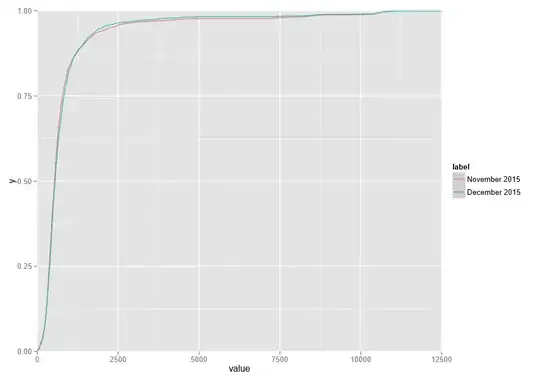I am taking measurements of a computer system performance over time and I'd like to understand if the performance is degrading or improving as time passes..
After doing some research, I picked the KS test for this comparison, and I'd like to confirm whether my understanding and application of the two-sample KS test to this problem is in fact correct or if I am doing it completely wrong.
Anyway, I have some time-series data, measuring my system response time (in milliseconds) for the months of November and December. Here are the sample results, summarised for brevity:
Label: "December 2015"
Samples: 3082
Percentiles:
0% 10% 50% 25% 50% 75% 90% 99% 100%
25.0 275.0 550.0 400.0 550.0 825.0 1425.0 9242.5 12500.0
Label: "November 2015"
Samples: 3717
Percentiles:
0% 10% 50% 25% 50% 75% 90% 99% 100%
25 275 550 375 550 775 1425 10346 11225
I generate ECDFs from the histograms and plot using R:
ggplot(data.frame, aes(x=value)) + stat_ecdf(aes(colour=label)) ...
The resulted plot looks like this:
From visual inspection, it is evident, that December results are generally better than November's, especially in the top quartile.
I run a two-sample KS test on the data as follows, using different alternative hypothesis:
ks.ts <- ks.test(cdf_November, cdf_December, alternative = "two.sided")
ks.lt <- ks.test(cdf_November, cdf_December, alternative = "less")
ks.gt <- ks.test(cdf_November, cdf_December, alternative = "greater")
This results in the following:
Two-sample Kolmogorov-Smirnov test
[1] "CDF(x) = November 2015"
[1] "CDF(y) = December 2015"
Hypothesis: two-sided (equal)
KS-statistic (D-value) = 0.0369063
p-value = 0.02030601
Hypothesis: the CDF of x lies below that of y
KS-statistic (D-value) = 0.01177649
p-value = 0.6266612
Hypothesis: the CDF of x lies above that of y
KS-statistic (D-value) = 0.0369063
p-value = 0.01015301
If I understood the KS test and interpreted the results correctly, this is what the test is telling me about my data:
Hypothesis #1: two-sided (equal)
The probability that both distributions are the same is 2.03% (p-value = 0.02030601).
Hypothesis #2: the CDF of x lies below that of y
The probability that CDF(November) is worse that CDF(December) is 62.6% (p-value = 0.6266612).
Hypothesis #3: the CDF of x lies above that of y
The probability that CDF(November) is better that CDF(December) is 1.01% (p-value = 0.01015301).
So from this I can say with some certainty, that November is worse that December.
Have I interpreted the results correctly or have I completely miss-understood the test (and possibly the purpose/application of the test)?
-- ab1
